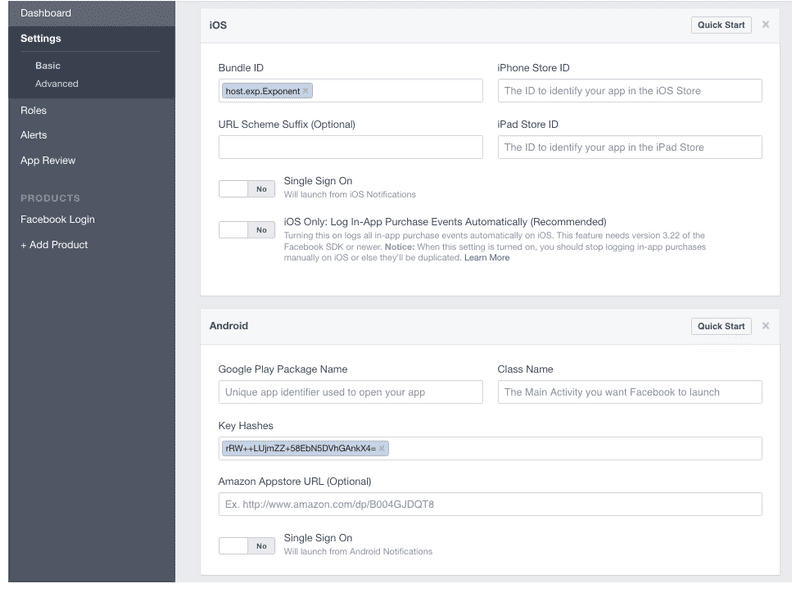Introduction
Guides
- Up and Running
- Development Mode
- Configuration with exp.json
- Viewing Logs
- Debugging
- Assets
- Preloading & Caching Assets
- Icons
- Using Custom Fonts
- Routing & Navigation
- Push Notifications
- Genymotion
- exp Command-Line Interface
- Building Standalone Apps
- How Exponent Works
- Upgrading Exponent
- Using ClojureScript
- Using Firebase
Provides Facebook integration for Exponent apps. Exponent exposes a minimal native API since you can access Facebook’s Graph API directly through HTTP (using fetch, for example).
Registering your app with Facebook
Follow Facebook’s developer documentation to register an application with Facebook’s API and get an application ID. Take note of this application ID because it will be used as the appId option in your Exponent.Facebook.logInWithReadPermissionsAsync call. Then follow these steps based on the platforms you’re targetting:
-
The Exponent client app
- Add
host.exp.Exponentas an iOS Bundle ID. AddrRW++LUjmZZ+58EbN5DVhGAnkX4=as an Android key hash. Your app’s settings should end up including the following under “Settings > Basic”:
- Add
-
iOS standalone app
-
Android standalone app
- Build your standalone app for Android.
- Run
keytool -list -printcert -jarfile YOUR_APK.apk | grep SHA1 | awk '{ print $2 }' | xxd -r -p | openssl base64(replaceYOUR_APK.apkwith the name of your APK file). - Add that output as an additional key hash in your Facebook developer page pictured above.
You may have to switch the app from ‘development mode’ to ‘public mode’ on the Facebook developer page before other users can log in.
Usage
Exponent.Facebook.logInWithReadPermissionsAsync(appId, options)
Prompts the user to log into Facebook and grants your app permission
to access their Facebook data.
param string appId
Your Facebook application ID. Facebook’s developer documentation describes how to get one.
param object options
A map of options:
- permissions (array) — An array specifying the permissions to ask for from Facebook for this login. The permissions are strings as specified in the Facebook API documentation. The default permissions are
['public_profile', 'email', 'user_friends']. -
behavior (string) — The type of login prompt to show. Currently this is only supported on iOS, and must be one of the following values:
'web'(default) — Attempts to log in through a modalUIWebViewpop up.'native'— Attempts to log in through the native Facebook app. This is only supported for standalone apps.'browser'— Attempts to log in through Safari orSFSafariViewController. This is only supported for standalone apps.'system'— Attempts to log in through the Facebook account currently signed in through the device Settings. This is only supported for standalone apps.
Returns
If the user or Facebook cancelled the login, returns { type: 'cancel' }.
Otherwise, returns { type: 'success', token, expires }. token is a string giving the access token to use with Facebook HTTP API requests. expires is the time at which this token will expire, as seconds since epoch. You can save the access token using, say, AsyncStorage, and use it till the expiration time.
Example
async function logIn() {
const { type, token } = await Exponent.Facebook.logInWithReadPermissionsAsync(
'<APP_ID>', {
permissions: ['public_profile'],
});
if (type === 'success') {
// Get the user's name using Facebook's Graph API
const response = await fetch(
`https://graph.facebook.com/me?access_token=${token}`);
Alert.alert(
'Logged in!',
`Hi ${(await response.json()).name}!`,
);
}
}Given a valid Facebook application ID in place of <APP_ID>, the code above will prompt the user to log into Facebook then display the user’s name. This uses React Native’s fetch to query Facebook’s Graph API.
© Copyright 2025, Exponent. Created using Gatsby.

